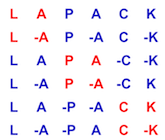 |
LAPACK 3.12.1
LAPACK: Linear Algebra PACKage
|
 |
LAPACK 3.12.1
LAPACK: Linear Algebra PACKage
|
| subroutine ssytrd | ( | character | uplo, |
| integer | n, | ||
| real, dimension( lda, * ) | a, | ||
| integer | lda, | ||
| real, dimension( * ) | d, | ||
| real, dimension( * ) | e, | ||
| real, dimension( * ) | tau, | ||
| real, dimension( * ) | work, | ||
| integer | lwork, | ||
| integer | info ) |
SSYTRD
Download SSYTRD + dependencies [TGZ] [ZIP] [TXT]
!> !> SSYTRD reduces a real symmetric matrix A to real symmetric !> tridiagonal form T by an orthogonal similarity transformation: !> Q**T * A * Q = T. !>
| [in] | UPLO | !> UPLO is CHARACTER*1 !> = 'U': Upper triangle of A is stored; !> = 'L': Lower triangle of A is stored. !> |
| [in] | N | !> N is INTEGER !> The order of the matrix A. N >= 0. !> |
| [in,out] | A | !> A is REAL array, dimension (LDA,N) !> On entry, the symmetric matrix A. If UPLO = 'U', the leading !> N-by-N upper triangular part of A contains the upper !> triangular part of the matrix A, and the strictly lower !> triangular part of A is not referenced. If UPLO = 'L', the !> leading N-by-N lower triangular part of A contains the lower !> triangular part of the matrix A, and the strictly upper !> triangular part of A is not referenced. !> On exit, if UPLO = 'U', the diagonal and first superdiagonal !> of A are overwritten by the corresponding elements of the !> tridiagonal matrix T, and the elements above the first !> superdiagonal, with the array TAU, represent the orthogonal !> matrix Q as a product of elementary reflectors; if UPLO !> = 'L', the diagonal and first subdiagonal of A are over- !> written by the corresponding elements of the tridiagonal !> matrix T, and the elements below the first subdiagonal, with !> the array TAU, represent the orthogonal matrix Q as a product !> of elementary reflectors. See Further Details. !> |
| [in] | LDA | !> LDA is INTEGER !> The leading dimension of the array A. LDA >= max(1,N). !> |
| [out] | D | !> D is REAL array, dimension (N) !> The diagonal elements of the tridiagonal matrix T: !> D(i) = A(i,i). !> |
| [out] | E | !> E is REAL array, dimension (N-1) !> The off-diagonal elements of the tridiagonal matrix T: !> E(i) = A(i,i+1) if UPLO = 'U', E(i) = A(i+1,i) if UPLO = 'L'. !> |
| [out] | TAU | !> TAU is REAL array, dimension (N-1) !> The scalar factors of the elementary reflectors (see Further !> Details). !> |
| [out] | WORK | !> WORK is REAL array, dimension (MAX(1,LWORK)) !> On exit, if INFO = 0, WORK(1) returns the optimal LWORK. !> |
| [in] | LWORK | !> LWORK is INTEGER !> The dimension of the array WORK. LWORK >= 1. !> For optimum performance LWORK >= N*NB, where NB is the !> optimal blocksize. !> !> If LWORK = -1, then a workspace query is assumed; the routine !> only calculates the optimal size of the WORK array, returns !> this value as the first entry of the WORK array, and no error !> message related to LWORK is issued by XERBLA. !> |
| [out] | INFO | !> INFO is INTEGER !> = 0: successful exit !> < 0: if INFO = -i, the i-th argument had an illegal value !> |
!> !> If UPLO = 'U', the matrix Q is represented as a product of elementary !> reflectors !> !> Q = H(n-1) . . . H(2) H(1). !> !> Each H(i) has the form !> !> H(i) = I - tau * v * v**T !> !> where tau is a real scalar, and v is a real vector with !> v(i+1:n) = 0 and v(i) = 1; v(1:i-1) is stored on exit in !> A(1:i-1,i+1), and tau in TAU(i). !> !> If UPLO = 'L', the matrix Q is represented as a product of elementary !> reflectors !> !> Q = H(1) H(2) . . . H(n-1). !> !> Each H(i) has the form !> !> H(i) = I - tau * v * v**T !> !> where tau is a real scalar, and v is a real vector with !> v(1:i) = 0 and v(i+1) = 1; v(i+2:n) is stored on exit in A(i+2:n,i), !> and tau in TAU(i). !> !> The contents of A on exit are illustrated by the following examples !> with n = 5: !> !> if UPLO = 'U': if UPLO = 'L': !> !> ( d e v2 v3 v4 ) ( d ) !> ( d e v3 v4 ) ( e d ) !> ( d e v4 ) ( v1 e d ) !> ( d e ) ( v1 v2 e d ) !> ( d ) ( v1 v2 v3 e d ) !> !> where d and e denote diagonal and off-diagonal elements of T, and vi !> denotes an element of the vector defining H(i). !>
Definition at line 189 of file ssytrd.f.